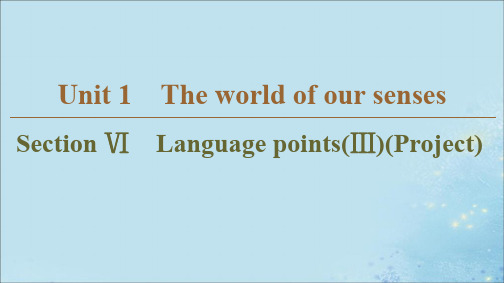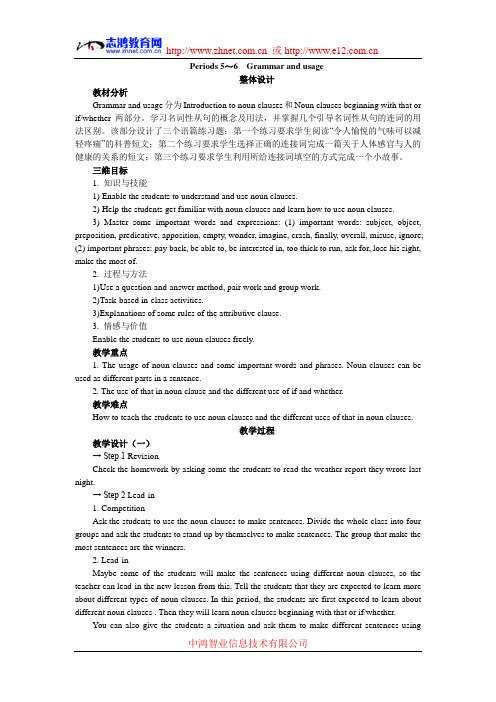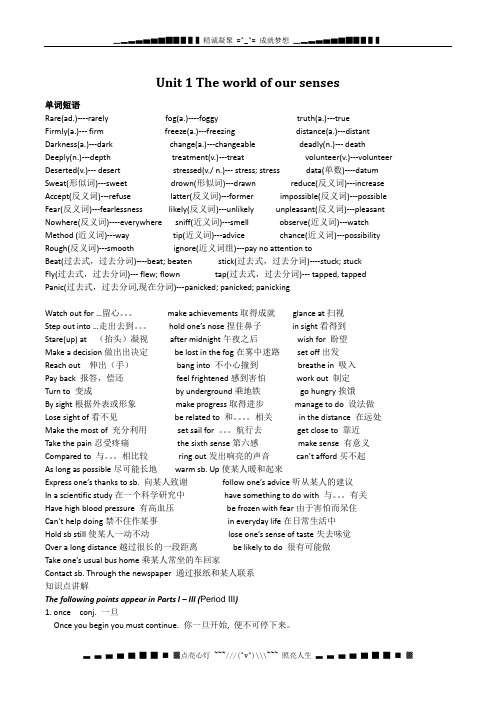Unit 1 The world of our senses period 3 教学设计-优质公开课-译林版必修3精品
- 格式:doc
- 大小:49.00 KB
- 文档页数:5


Unit 1 The world of our sensesPeriod One Welcome to the unit & ReadingⅠ.单项填空1.Since we have failed many times,we should take a new approach________the problem. A.about solving B.to solvingC.of solving D.in solving答案 B解析an approach to...意为“……的方法”,其中to为介词,后跟名词、代词或动名词。
2.The boy was observed________basketball at eight o’clock yesterday.A.playing B.playC.to play D.having played答案 A解析根据时间状语及句意可知,应选择一个表动作正在进行的选项作主语补足语。
B、D两项语法错误;C项表动作完成;A项表动作正在进行,因此选A项。
3.Mrs.Smith finds it hard to clear up the mess,as her children are always ________ whenever she tries to.(2013·福建,29)A.in the way B.on watchC.in sight D.on the line答案 A解析句意为:Mrs.Smith发现很难清理混乱局面,由于当她尽力清理时她的孩子总是妨碍她。
in the way妨碍;on watch值班,监视;in sight在视力范围内,在即;on the line 处于危险中,(对方)在接电话。
4.It’s im portant for advertisers to________ their message________ customers. A.get;across to B.make;knownC.get;down D.make;knowing to答案 A解析get sth.across to sb.把……向某人讲清楚。

Unit 1 The world of our senses 6-12课时教师版导学案Studying aims:1. Enriching our vocabulary.2. Mastering some key words and expressions.Self-education(自主学习):Task 1: Read and recite all the new words and expressions showed on pages67(1-9).Task 2: Write down the parts of speech and their meanings of the following wordsignore __, sweat __, distance__, attach __, unlike __disability __, hopeful __, whisper __, bite __, contrary __,attract__, calm __, panic __, employ __,Team work(合作探究):Please fill in the following blanks.1. distance n. _距离___→___distant____ adj.遥远的→ distantly adv. adv. 远离地;疏远地;2. avoid vt.____→avoidable adj.可避免的,可回避的→avoidance n.回避,躲开3. add vt._____→_addition_____ n.添加→adj. additional 附加的,额外的additive 附加的;[数] 加法的addable 可增加的4.attach vt. _____→attachable adj. 可附上的;可连接的; attachment n.附件;依恋;连接物5. disability n. _____→disable vt. 使失去能力;使残废; unable adj.不会的,不能的;无能力的;不能胜任的→able adj.有能力的;能干的6. panic vt&n.恐慌;惊慌;→过去式panicked 过去分词panicked →现在分词panicking Target detection (目标检测):Task 1 Translation:1.远处________2.波浪________3.在头上方________4.满足需要________5.相反的________6.镇静的________7.有希望的________8.可能的________9.不像________10.雇佣________Task 2 Fill in the blanks1.This hospital is attached to the medical college nearby.这个医院附属于附近的那所医学院。


Periods 5~6Grammar and usage整体设计教材分析Grammar and usage分为Introduction to noun clauses和Noun clauses beginning with that or if/whether两部分。
学习名词性从句的概念及用法,并掌握几个引导名词性从句的连词的用法区别。
该部分设计了三个语篇练习题:第一个练习要求学生阅读“令人愉悦的气味可以减轻疼痛”的科普短文;第二个练习要求学生选择正确的连接词完成一篇关于人体感官与人的健康的关系的短文;第三个练习要求学生利用所给连接词填空的方式完成一个小故事。
三维目标1. 知识与技能1) Enable the students to understand and use noun clauses.2) Help the students get familiar with noun clauses and learn how to use noun clauses.3) Master some important words and expressions: (1) important words: subject, object, preposition, predicative, apposition, empty, wonder, imagine, crash, finally, overall, misuse, ignore;(2) important phrases: pay back, be able to, be interested in, too thick to run, ask for, lose his sight, make the most of.2. 过程与方法1)Use a question-and-answer method, pair work and group work.2)Task-based in-class activities.3)Explanations of some rules of the attributive clause.3. 情感与价值Enable the students to use noun clauses freely.教学重点1. The usage of noun clauses and some important words and phrases. Noun clauses can be used as different parts in a sentence.2. The use of that in noun clause and the different use of if and whether.教学难点How to teach the students to use noun clauses and the different uses of that in noun clauses.教学过程教学设计(一)→ Step 1 RevisionCheck the homework by asking some the students to read the weather report they wrote last night.→ Step 2 Lead-in1. CompetitionAsk the students to use the noun clauses to make sentences. Divide the whole class into four groups and ask the students to stand up by themselves to make sentences. The group that make the most sentences are the winners.2. Lead-inMaybe some of the students will make the sentences using different noun clauses, so the teacher can lead-in the new lesson from this. Tell the students that they are expected to learn more about different types of noun clauses. In this period, the students are first expected to learn about different noun clauses . Then they will learn noun clauses beginning with that or if/whether.You can also give the students a situation and ask them to make different sentences usingnoun clauses:Suppose a sports meeting will be held in our school, the students are talking about the sports meeting.Suggested answers:1) Have you heard of the news that there will be a sports meeting in our school?2) I don‟t know whether the news is true.3) It is true that a sports meeting is going to be held in our school.4) The fact is that a sports meeting will be held in our school.→ Step 3 Grammar1. Introduction to noun clausesNoun clauses have the same functions in a sentence as those of nouns or noun phrases. Here the students will learn that noun clauses can be used as different parts in a sentence. Noun clauses can be used as the subject, the object and the predicative of a sentence. A noun clauses can also be used in apposition to a noun.2. Write down the following sentences on the blackboard and ask the students to read these sentences. Ask them to point out the subordinate clauses or clauses in each sentence. You can underline the subordinate clauses with coloured chalk.1) At lunchtime, the radio weatherman reported that the mist would become a thick fog in the afternoon.2) She wondered if the buses would still be running.3) The truth is that the fog is too thick for the bus to run that far.4)What surprised me most was that the old man couldn‟t see anything.Help the students find out the functions of each clause in the sentence. Tell the students that because the clauses in these sentences have the same function as noun or noun phrases, they are called noun clauses.Task 1 Introduce the usage of noun clauses1. We can use a noun clause as the subject of a sentence.Ask the students to read Part 1 on page 8 so that they will know that a noun clause can be used as the subject of a sentence. When a noun clause is used as the subject in a sentence, it is called the subject clause. Tell them that the words used to introduce noun clauses are called conjunctions. Ask them to point out the conjunctions in each sentence.We can use it as an empty subject.Have the students read the sentence in which it is used as an empty subject. You can explain that sometimes it is put at the beginning of a sentence and used as the formal subject while the noun clause is put at the end. This is because in English people usually put long or complicated items at the end of a sentence. Therefore, it can also be called a “preparatory subject”.2. Ask the students to read Part 2 so that they will know that a noun clause can be used either as the object of a verb or a preposition in a sentence. When a noun clause is used as the object in a sentence, it is called the object clause. Have the students point out the conjunctions used to introduce the object clauses in the example sentences.Ask the students to read the two sentences in which it is used as an empty object. Tell them that when both an object clause and an adjective as an object complement are used after the predicate verb, we can use it as an empty object after the verb. We would then put the object clause after the object complement.E. g. We all thought it good news that the fog had finally gone.In this sentence , “it” is an empty object and “that the fog had finally gone” is object, “good new s” is used as object complement.3. Ask the students to read Part 3 so that they will know that a noun clause can be used as the predicative after the link verb be. When a noun clause is used as the predicative, it is called the predicative clause. Have the students point out the conjunctions used to introduce the predicative clauses.Explain to the students that as if/as though, because, why can also he used in predicative clause. Sometimes the predicative clause can be used after the link verb seem or appear.E. g. It seems as if it is going to rain.4. Explain to students what apposition means. Write down the following examples on the blackboard. The bold part in each sentence can be written in red.1)Polly, a twenty-year-old young lady, was led home by an old man in a heavy fog.2)The book A Brief History of Time‟ was written by Stephen Hawking, a great scientist.3)The fact that Polly didn‟t ask for the man‟s name is a pity.Tell the students that the red parts in the three sentences are in apposition. That is to say, a noun, a noun phrase or a noun clause is placed equivalently with another noun as an explanatory part. They both have the same syntactic relation to the other elements in the sentence. When a noun clause is used in apposition to a noun, it is called the appositive clause. Ask the students to point out the conjunction used to introduce the appositive clause in the last sentence.Then have the students read Part 4. Ask them to tell you the types of nouns that are used before the appositive clause. They should be able to work out that the noun with an appositive clause is usually an abstract noun, such as news, fact, idea, truth or theory. If we definite information, an appositive clause can strengthen it.5. Have the students read Part 5. Then ask them to go through Parts 1 to 5 and point out all the conjunctions used in the sentences on page 8. You can write down these conjunctions on the blackboard, so the students can see clearly what words can be used as conjunctions to introduce noun clauses.Task 2 PracticeAsk the students to read the article on page 9 and to describe the main idea in their own words. Make sure that they know what they need to do and that they can identify all the noun clauses. Ask the students to identify the subject, object, predicative, or appositive clauses. They should also point out the conjunction in each clause.Suggested answers:Paragraph 1The possibility that pleasant smells might reduce pain has recently been suggested by new research. 最新的研究表明香味也许会有减少疼痛的可能性。

Unit 1 The world of our senses单词短语Rare(ad.)----rarely fog(a.)----foggy truth(a.)---trueFirmly(a.)--- firm freeze(a.)---freezing distance(a.)---distant Darkness(a.)---dark change(a.)---changeable deadly(n.)--- death Deeply(n.)---depth treatment(v.)---treat volunteer(v.)---volunteer Deserted(v.)--- desert stressed(v./ n.)--- stress; stress data(单数)----datum Sweat(形似词)---sweet drown(形似词)---drawn reduce(反义词)---increase Accept(反义词)---refuse latter(反义词)---former impossible(反义词)---possible Fear(反义词)---fearlessness likely(反义词)---unlikely unpleasant(反义词)---pleasant Nowhere(反义词)----everywhere sniff(近义词)---smell observe(近义词)---watch Method (近义词)---way tip(近义词)---advice chance(近义词)---possibility Rough(反义词)---smooth ignore(近义词组)---pay no attention toBeat(过去式,过去分词)----beat; beaten stick(过去式,过去分词)----stuck; stuckFly(过去式,过去分词)--- flew; flown tap(过去式,过去分词)--- tapped, tapped Panic(过去式,过去分词,现在分词)---panicked; panicked; panickingWatch out for …留心。
Module 3 Unit1 The world of our senses -Period 2教材分析与导入(牛津版模块3)unit 1 T h e w o r l d o f o u r s e n s e sPeriod 2 (Word power & Grammar)1. 教材分析1.三维目标1.Knowledge and skills◆To enlarge Ss’s vocabulary about weather.◆To help Ss learn that many words in English can have different parts of speech.◆To introduce noun clauses to Ss.◆To recognize differences between if and whether.4. To recognize the basic forms of the to-infinitive and the bare infinitive.5. To recognize the basic form of the verb-ing.6. To learn how to use the noun clauses.B. Process and methodspetition to stimulate them to act quicky and actively.2.Association to increase their interest and enlarge their vocabulary.3.Present the usage of " noun clauses "in different situations.4.Note-making5.Expanations of noun clauses.6.Discussion to help students understand better what they have learned.C. Emotion, attitude and values1.To arouse the students' interest in describing the weather.2.To make them always have a optimistic attitude in different weather.3.To have an awareness of the usage of "noun clauses ".(3)教学重点•To remember some words related toweather.•How to make them to describe different types of weather.•How to get students master the noun clauses .(2)教学难点•How to make the students master the noun clauses.•How to get students distinguish if from whether .•How to use different types of parts of speech properly.(3)教学建议1 .Encourage the students to describe different types of weather in English.2. Have discussions in pairs or in groups.3. Apply multimedia to teaching4. Explanations of some grammatical points新课导入设计导入一Lead-in(1)Questions for students to answerWhich word is used twice besides the noun "street" in the two sentences?1. Once out in the street, she walked quickly towards her usual bus stop.2. ‘Here we are, King Street.’ he stopped.Answer : stopLead-in(2)T: If you meet one of your friends, what kind of topic will you start with?S1: I'll say “Hello! Have you had your breakfast, lunch or supper?”T: Yes, that is our Chinese custom to start a conversation. Who can tell me, what kind of topic British people start with when they meet?S2: They always start the conversation by talking about the weather.T: Yes. When you meet British people, if you say “Have you had you lunch?”, he or she may feel very surprised. He or she may think that you will treat him or her. So we should know something about different ways of communication between east and west countries. Now, let’s read the following conversation between two neighbors. I’ll give you 3 minutes, after that please have a discussion, and list the names of different kinds of weather.。
Unit 1 The world of our senses【导读】《小妇人》这部小说以家庭生活为描写对象,以家庭成员的感情纠葛为线索,描写了马奇一家的天伦之乐。
马奇家的四姐妹中,无论是为了爱情甘于贫困的梅格,还是通过自己奋斗成为作家的乔,以及坦然面对死亡的贝思和以扶弱为己任的艾美,虽然她们的理想和命运都不尽相同,但是她们都具有自强自立的共同特点。
Little Women(Excerpt)“Christmas won't be Christmas without any presents,”grumbled Jo,lying on the rug.“It's so dreadful to be poor!” sighed Meg,looking down at her old dress.“I don't think it's fair for some girls to have plenty of pretty things,and other girls nothing at all,” added little Amy,with an injured sniff.“We've got Father and Mother,and each other,” said Beth contentedly from her corner.The four young faces on which the firelight shone brightened at the cheerful words,but darkened again as Jo said sadly,“We haven't got Father,and shall not have him for a long time.” She didn't say “perhaps never”,but each silently added it,thinking of Father far away,where the fighting was.Nobody spoke for a minute; then Meg said in an altered tone,“You know the reason Mother proposed not having any presents this Christmas was because it is going to be a hard winter for everyone; and she thinks we ought not to spend money for pleasure,when our men are suffering so in the army.We can't do much,but we can make our little sacrifices,and ought to do it gladly.But I am afraid I don't,” and Meg shook her head,as she thought regretfully of all the pretty things she wanted.“But I don't think the little we should spend would do any good.We've each got a dollar,and the army wouldn't be much helped by our giving that.I agree not to expect anything from Mother or you,but I do want to buy UndineandSintran for myself.I've wanted it so long,” said Jo,who was a bookworm.小妇人(节选)“没有礼物圣诞节怎么过?”乔躺在小地毯上咕哝。
Unit 1 The world of our senseProject Producing a TV showTeaching Aims:1.Do some reading and improve the students’ reading ability2.Improve the students’ integrating abilities by working together and producinga TV showTeaching important points1.Read and know how sharks use their senses to survive dangers in their environment.2.Make sure the students know how to produce a TV show.Teaching difficult pointHow to produce a TV showTeaching procedures:Step 1 GreetingsGreet the whole class as usual.Step2 Lead inWhat do you know about sharks? Do sharks eat human beings?Step 3 Fast reading1. How many different types of sharks are there in the ocean?4002. Do all of them attack humans?30 types3. How to avoid being attacked by sharks?Hit and tun Bump ang bite sneak4. What are their unique senses?Don’t swim in the dark.Don’t swim if you are cut or if you have a fresh wound.Don’t wear bright clothing or jewellery.Try and stay in groups.5. What’s the tips if a shark attacks you?Don’t panic. Hit the shark on the nose. Stick your finger in the shark’s eye.Step4 detailed reading1) Read the text again and try to find out the main idea of each paragraph.Paragraph 1: There are nearly 400 types of sharks.Paragraph 2: Sharks do not feed on humans.Paragraph 3: There are three types of shark attracks.Paragraph 4: An increase in water sports has led to an increase in shark attacks.Paragraph 5: There are three tips on what to do if a shark attacks.Paragraph 6: Do not be frightened by sharks.2)Fill in the informationThree fierce sharks :a.the great white sharkb. the tiger sharkc. the bull sharkStep 5 DiscussionRead text again and find out what unique senses sharks have,what senses sharks use to attack humans and what people can do to protect themselves.Sharks can see in the darkTo survive: stick your finger in the sharks’ eye when it attacks you.Sharks can smell blood far away.To survive:hit the shark on the nose when it attacks you.Step6 Producing a TV showPlanningA. Get into groups(4-6)B. Decide which topic your group will prepare.A.PreparingVisit a zoo , watch an animal documentary,look at books, surf theInternet……to find information about the animal.B.Producing1. Focus your research on how your animal uses its senses.2. TV is very visual so pictures should be presented in an easy to see way.3. Each member must work on different part of the show, keeping in mind theoverall design.4. Each member has to proofread the writing at least once, correct mistakes if there are any, and add any new ideas they can think of.Step 7 HomeworkFind out more information about your animals。
Unit 1 period 3 教学设计Teaching goals:1.Do some reading.2.Improving Ss’ ability of writing.3.Get Ss to cooperate with others.Teaching important and difficult points:1.Know the general idea of the passage.2.Make sure Ss know how to write an interesting story.The first period:Teaching proceduresStep 1 Reading1. Ask students to read the article Shark attacks and find out as much information as they can about sharks.2. Have students read the article again and ask them to find out what unique senses sharks have,what senses sharks use to attack humans and what people can do to protect themselves.3. Read the article and fill in the form below:_________1_____________Suggested answers: shark attacks,dangerous sharks,the bull shark,three types’ attacks,hit and run,second, a “sneak”,safety, a fresh wound,do not panicStep 2 Language points1. Most people know that the most dangerous shark is the great white shark,mainly because theyhave seen the movie ‘jaws’.most 前面加the表示最高级,不加the表示大多数mostly 一般地/通常adv.e.g.: The sauce is mostly ream.We’re mostly out on Sundays.mainly总体/大致adv.e.g.: The people in the hotel were mainly tourists.The population almost doubles in summer mainly because of the jazz festival.2. The chances of being attacked by a shark are very small compared to other dangersChance c.n possibility chance of doing sth.e.g. :Is there any chance of getting tickets for tonight?She has a slim chance that he will change his mind.by chance 偶然地e.g.: I met my classmate in primary school the other day on the street by chance.opportunitye.g.: It was the chance he had been waiting for.I w on’t give him a second chance.3. The low number of attacks that happen every year proves that sharks do not feed on humans if they have the choice.prove (1) 证明prove sth. to sb.e.g.: Give me a chance and I will prove it to you.(2) link verb 证明是e.g.: The experiment proved a failure.(3) prove oneself to sb. 显示e.g.: He constantly feels he has to prove himself to others.4. When attacking in this way,the shark waits for you to swim by and attacks you suddenly.此句为省略句. When the shark is attacking in the this way,the shark waits for you to swim by and attacks you suddenly.在状语从句当从句主语与主句主语一致,且从句的谓语动词有be动词,从句的主语与be 动词都能省略5. Recently,shark attacks have been increasing as water sports are becoming more popular.as 表一种伴随的原因意思上相当于becausee.g.: My English improves a lot as I use it every day.1. Hit the shark on the nosehit sb. on(硬的)/in(软的) + the + 身体的部位Step three: HomeworkExercise in the newspaper on page 4The second period:Producing a TV show Period Two:Teaching aims:To do the project of producing a TV show about how an animal uses its senses.Teaching procedures:Step 1: Check homeworkStep 2: PlanningTeacher: Every student has to tell their classmates what animal they would like to introduce if they could. The things you consider before you start your TV show:1 what kind of animal do you want to introduce in your TV show?2 why do you want to introduce such an animal?3 what is your TV show going to say on the animal?4 what is the purpose of your TV show?Step 3: PrepareTasks Person in chargeCollect information Student A and BEdit a TV show Student CPresent the show Student DStep 4: Produce1.Group members who are editing the TV show will have to draft the article2.based on all the ideas from our previous research and discussion.3.When the draft is done,each member should read it carefully and give suggestions on itswording and design.Example:Steps Tasks Person in chargePlanning Decides name of the TV show All the membersPreparing Design activities Student A and BProducing Draft the TV show Student CPresenting Give a presentation Student DStep 5: requirementsTeacher: Each group will have 3 to 4 minutes to express your TV show. Please do remember to use your imagination to make your TV show interesting and good. We will,of course,to choose the best one and record the TV show. By the way,your article which you wrote for your TV show should be photocopied and give every other group and me one copy.Step 6: Homework1. Produce your TV show.2. Prepare for a test.Self-assessmentTeaching goals:This part at the end of the unit aims to allow students to determine what they have achieved and what else they can do to improve their study.Teaching procedures:1 让每一个小组上台表演自己的TV show.由老师和学生同时打分.评分细则:对所写文章的评分: 50是否用上名词性从句10是否用上四个本单元学过的词组10是否用上四个本单元学过的重点单词10句子是否通顺. 10单词拼写是否正确10对表演评分: 50是否仪表端正10是否语言清晰,语调语音好听10表演整体艺术是否专业10 是否体现团队合作10 TV show 是否有原创精神10 2 老点评和学生代表谈看法.。